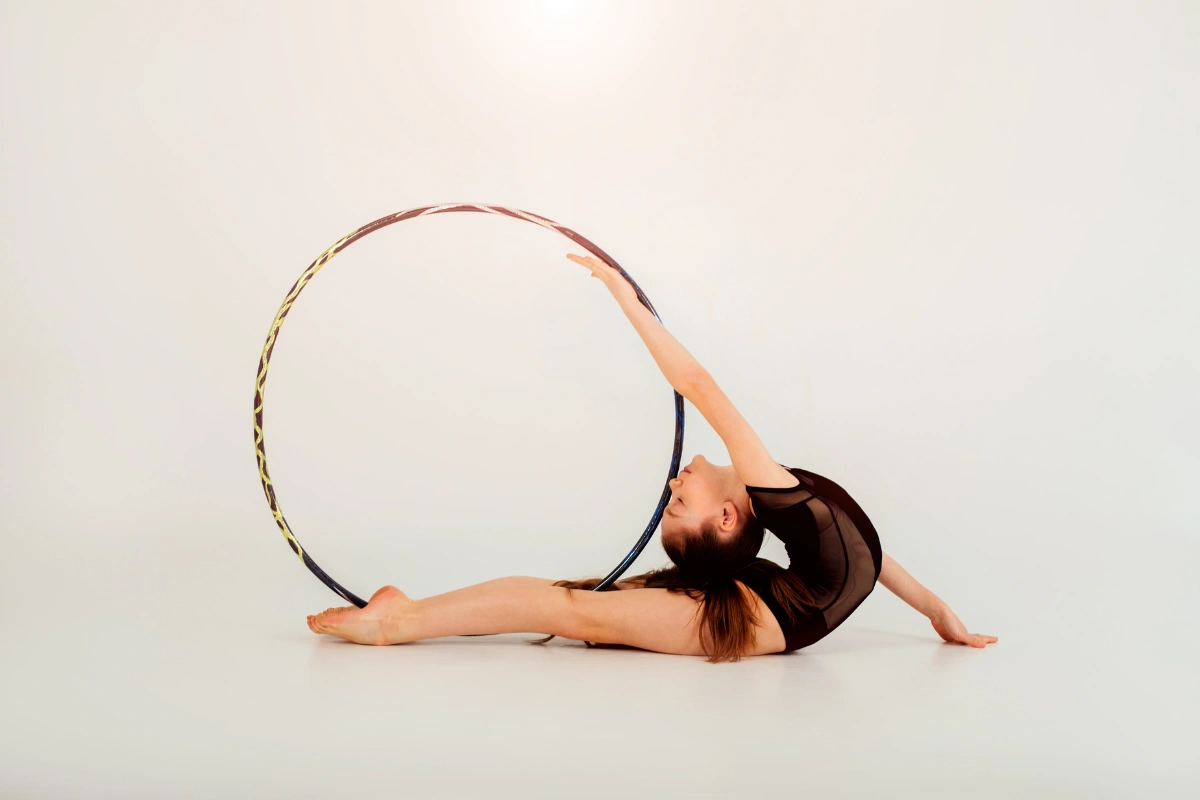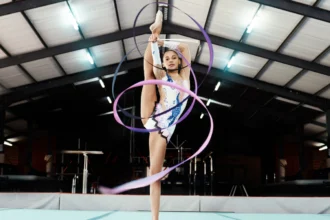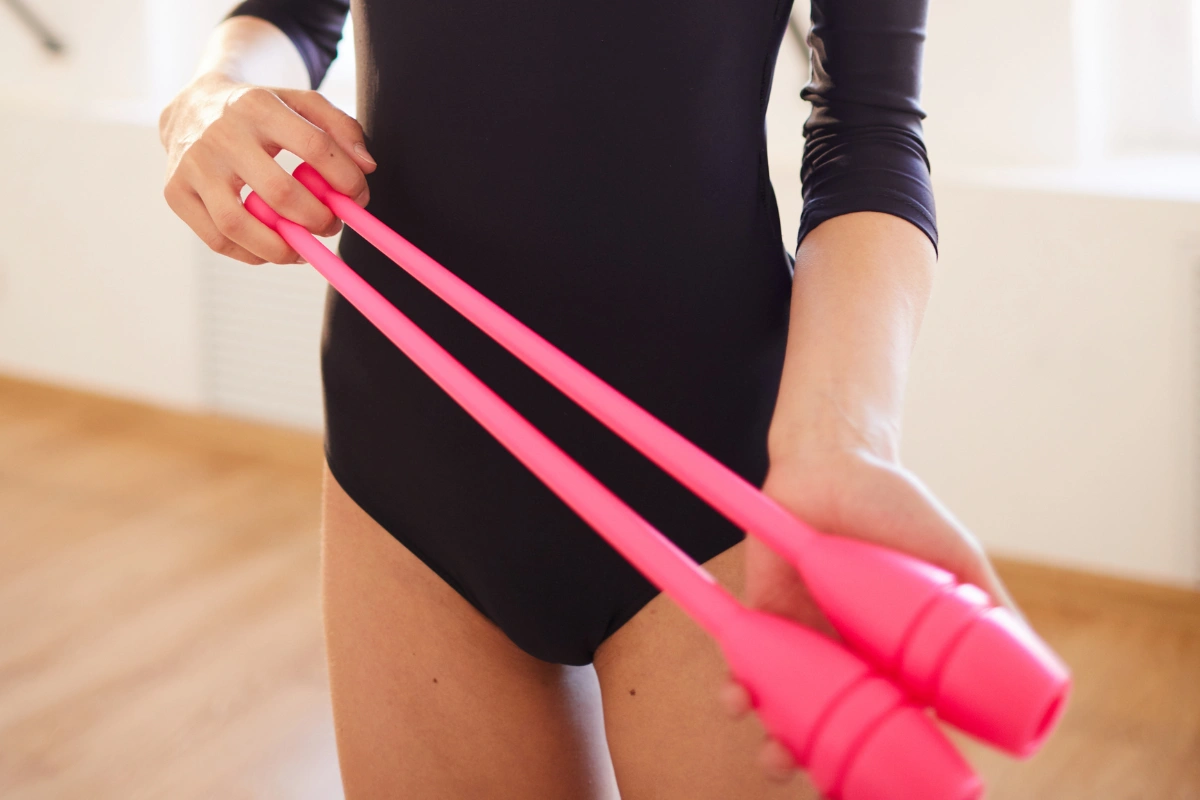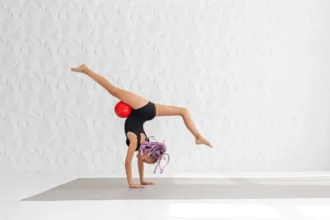The hoop in rhythmic gymnastics is a versatile and essential apparatus, typically made from plastic or wood. With an interior diameter ranging from 80 to 90 cm and a minimum weight of 300 grams, it is designed to perform a wide range of movements, such as rolling, rotating, throwing, catching, swinging, and circling.
Some of the fundamental skills include:
- Rolling: This involves the hoop rolling along the floor, either by pushing it with a hand or foot or using the body to guide its path. It’s one of the most basic movements and helps improve coordination and control.
- Rotating: The hoop is spun in the hands or around the body, requiring precision and timing to maintain continuous motion. This can include wrist rotations or full-body spins.
- Throwing and Catching: This skill involves tossing the hoop into the air and catching it at the right moment. It helps develop hand-eye coordination and timing.
- Swinging: The hoop is swung from side to side or in circular motions, often while the gymnast moves through various postures or body movements. This skill requires fluid motion and balance.
- Circling: A movement where the gymnast uses the hoop to create a continuous circle, either on the floor or in the air, often combined with body movements or spins.
These skills form the foundation for more advanced routines and tricks, which can be combined for dynamic performances in rhythmic gymnastics.
Next, we’ll cover some fundamental hoop techniques, from simple hand rotations to more advanced elements like rolls and spirals. Whether you’re just starting or looking to improve your skills, this guide will walk you through each step.
1. Hand Rotation Basics
Hand rotations are the foundational skill for working with the hoop in rhythmic gymnastics. The first thing you need to focus on is how to rotate the hoop smoothly on your hand.
Begin by holding the hoop between your thumb and fingers, positioning it comfortably on your hand without letting it slide up your arm. Keep your elbow slightly bent, and use your wrist to rotate the hoop in a smooth circular motion.
The goal is to keep the hoop’s plane level as it rotates. If you find the hoop sliding up your arm, gently adjust your grip to maintain control.
Practice Tip:
- Start by performing 10 rotations with your right hand, then switch to your left hand. As you rotate the hoop, pay attention to keeping the hoop as flat as possible. To help with this, imagine a horizontal plane around your wrist that the hoop should stay aligned with.
2. Mirror Plane Rotations
Mirror plane rotations take your hand rotation skills to the next level. In this skill, you’ll rotate the hoop on both hands at the same time, ensuring the hoop’s movement mirrors itself in front of your body.
Begin by performing hand rotations on your right hand, then on your left, ensuring both rotations occur in sync.
Keep the hoop’s plane flat as you work to mirror the rotations. Watch the movement of your wrists carefully to ensure precision and avoid tilting the hoop.
Practice Tip:
- Start by doing 10 rotations on your right hand and then 10 on your left. Afterward, reverse the direction of the rotations to challenge your coordination. Practicing this will also improve your overall timing and symmetry.
3. Wheel Plane Rotations
In contrast to mirror plane rotations, wheel plane rotations involve the hoop moving sideways, rather than in front of you. This requires increased wrist control and less reliance on your shoulder.
The hoop should travel along the horizontal plane as it moves sideways, and you must keep the wrist engaged to guide the hoop’s movement. To avoid strain, keep your elbow slightly bent and focus on fluid wrist action rather than large shoulder movements.
Practice Tip:
- Perform 10 rotations on your right hand, then 10 on your left. After completing these rotations, reverse the direction and practice again. Switching directions helps to build your ability to control the hoop from multiple angles.
4. Spirals
Spirals are a dynamic element where the hoop spins on your hand like a top. This move requires both control and finesse.
Start by positioning the hoop on the palm of your hand, with your palm facing upward. Use a quick flick of your wrist to initiate the spinning motion, and keep your palm facing down as the hoop rotates.
The key is to let the hoop spin evenly and smoothly, with no jerky movements. As the hoop spins, focus on controlling the speed and trajectory to avoid wobbling.
Practice Tip:
- Do 10 repetitions of spiral rotations, focusing on keeping the hoop stable and balanced throughout the spin. As you get more comfortable, experiment with increasing the speed of the spiral, but make sure to maintain control and avoid any instability.
5. Tossing the Hoop
Tossing the hoop is a skill that adds grace and flair to your routine. Begin by holding the hoop flat like a table in front of you, making sure it is positioned evenly with your thumbs on top and your fingers supporting it from below.
Slightly bend the hoop downward to give it a bit of force, and then use your hands to push the hoop upward into the air for a controlled toss. The height and speed of the toss can vary based on your skill level, but it’s important to maintain a smooth release.
Practice Tip:
- Perform 20 tosses, gradually increasing the speed as you grow more confident in your control. Start with a gentle toss and then aim for higher, quicker tosses. The key is maintaining control over the hoop’s flight path so it returns to your hands without veering off course.
6. Passing the Hoop Around the Body
Passing the hoop around your body is a technique that involves moving the hoop in a smooth, continuous motion.
Start by passing the hoop around your waist, ensuring that it stays flat and doesn’t tilt. This is important, as tilting the hoop can lead to deductions in performances. Keep the hoop moving smoothly around your waist, and when you get comfortable, try passing it around other body parts like your knees, shoulders, or even your neck.
Practice Tip:
- Begin by doing 20 repetitions in one direction, and then switch to the opposite direction for another 20. As you gain proficiency, challenge yourself by increasing the speed or trying more complex passes, like passing the hoop around your knees or behind your back.
7. Skipping Through the Hoop
Skipping through the hoop is a rhythmic gymnastics classic that requires timing and agility. To begin, hold the hoop vertically and place it at a manageable height for jumping through.
Jump through the hoop in a smooth, controlled manner, ensuring that your feet clear the hoop without making contact. The key is to maintain fluidity and speed as you perform each jump, moving in and out of the hoop without hesitation.
Practice Tip:
- Perform 20 repetitions, focusing on jumping through the hoop without pausing or tripping. As you improve, try to increase the speed of your movements and challenge yourself by attempting multiple jumps in a row, all while maintaining control of the hoop.
8. Rolling the Hoop
Rolling the hoop is an advanced technique that requires a combination of finesse and precision. The hoop should roll smoothly across the floor or over your body.
To begin, practice rolling the hoop over your back, ensuring that it remains level and controlled throughout the movement. Focus on keeping the hoop’s momentum even so it doesn’t wobble or lose speed. This skill can be challenging, but with consistent practice, you’ll be able to execute the roll with grace and fluidity.
Practice Tip:
- Start by attempting 20 rolls, alternating hands to ensure even control of the hoop. Focus on keeping the roll smooth and even, and as you get more comfortable, experiment with rolling the hoop in different directions, such as across the floor or around your body.
By now, you should have a solid understanding of the basic rhythmic gymnastics hoop techniques. These exercises may seem simple at first, but they’re the building blocks for more complex routines. Keep practicing, and soon you’ll find that your control, speed, and coordination improve.





